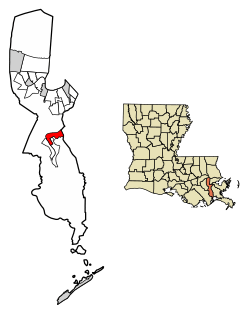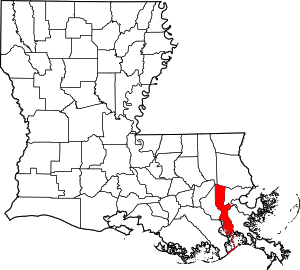Jean Lafitte, Louisiana
Jean Lafitte is a town on Bayou Barataria in Jefferson Parish, Louisiana, United States. It is named after the privateer Jean Lafitte. The population was 1,903 at the 2010 census.[6] It is part of the New Orleans–Metairie–Kenner Metropolitan Statistical Area.
Jean Lafitte, Louisiana | |
|---|---|
Town | |
| Town of Jean Lafitte | |
 A portion of Jean Lafitte, Louisiana, along the Gulf Intracoastal Waterway and Bayou Barataria | |
 Flag | |
 Location of Jean Lafitte in Jefferson Parish, Louisiana. | |
.svg.png) Location of Louisiana in the United States | |
| Coordinates: 29°44′10″N 90°07′36″W[1] | |
| Country | United States |
| State | Louisiana |
| Parish | Jefferson |
| Government | |
| • Mayor | Timothy P. Kerner (D)[2][3] |
| Area | |
| • Total | 6.21 sq mi (16.09 km2) |
| • Land | 5.85 sq mi (15.15 km2) |
| • Water | 0.36 sq mi (0.93 km2) |
| Elevation | 3 ft (0.9 m) |
| Population (2010) | |
| • Total | 1,903 |
| • Estimate (2019)[5] | 2,000 |
| • Rank | JE: 5th |
| • Density | 341.88/sq mi (132.00/km2) |
| Time zone | UTC-6 (CST) |
| • Summer (DST) | UTC-5 (CDT) |
| Area code(s) | 504 |
| FIPS code | 22-38092 |
| Website | www |
| |
Geography
Jean Lafitte is located at 29°44′10″N 90°07′36″W (29.735587, -90.122053).[6]
According to the United States Census Bureau, the town has a total area of 6.3 square miles (16 km2), of which 6.0 square miles (16 km2) is land and 0.3 square miles (0.78 km2) (4.47%) is water.
History
In 2012, a historical marker for the community of Manila Village was placed in Jean Lafitte.[7] Since mid-2013, Manila Plaza, located in front of Jean Lafitte Town Hall, has held several historical markers and commemorative plaques acknowledging important individuals in the area's Filipino American history.[8] The Philippine-Louisiana Historical Society participated in the dedication ceremony.[8][9]
While there were several settlements of Filipinos (sometimes called Manilamen or Tagalas) along the Louisiana coast in the late 19th century, Manila Village was the largest. The residents there implemented a system of platforms on which they dried shrimp, as forerunners of Louisiana's 21st-century dried shrimp industry. This community-on-stilts thrived for nearly a century, until it was destroyed by Hurricane Betsy in 1965.[10]
Demographics
| Historical population | |||
|---|---|---|---|
| Census | Pop. | %± | |
| 1980 | 936 | — | |
| 1990 | 1,469 | 56.9% | |
| 2000 | 2,137 | 45.5% | |
| 2010 | 1,903 | −10.9% | |
| Est. 2019 | 2,000 | [5] | 5.1% |
| U.S. Decennial Census[11] | |||
As of the census[12] of 2000, there were 2,137 people, 721 households, and 575 families residing in the town. The population density was 357.5 people per square mile (138.0/km2). There were 767 housing units at an average density of 128.3 per square mile (49.5/km2). The racial makeup of the town was 93.03% White, 0.61% African American, 2.76% Native American, 1.31% Asian, 0.14% Pacific Islander, 0.33% from other races, and 1.82% from two or more races. Hispanic or Latino of any race were 1.87% of the population.
There were 721 households, out of which 39.9% had children under the age of 18 living with them, 64.2% were married couples living together, 9.6% had a female householder with no husband present, and 20.2% were non-families. 15.8% of all households were made up of individuals, and 8.2% had someone living alone who was 65 years of age or older. The average household size was 2.96 and the average family size was 3.31.
In the town, the population was spread out, with 27.2% under the age of 18, 11.7% from 18 to 24, 28.5% from 25 to 44, 23.4% from 45 to 64, and 9.3% who were 65 years of age or older. The median age was 34 years. For every 100 females, there were 110.7 males. For every 100 females age 18 and over, there were 108.3 males.
The median income for a household in the town was $35,833, and the median income for a family was $40,163. Males had a median income of $32,025 versus $22,697 for females. The per capita income for the town was $14,209. About 14.2% of families and 17.0% of the population were below the poverty line, including 19.4% of those under age 18 and 24.7% of those age 65 or over.
Education
Lafitte residents are zoned to Jefferson Parish Public Schools.
Residents from K-6 are zoned to Leo E. Kerner Elementary School (formerly Lafitte Elementary School). 7-12 are zoned to Fisher Middle-High School.
The Leo. E. Kerner Jr. City Park Multi-Purpose Complex is located in Jean Lafitte. Jefferson Parish Library operates the Lafitte Library inside the complex. The over 4,500 square feet (420 m2) facility, which is almost three times larger than the previous library facility, opened on March 4, 2010. The previous library facility sustained damage during Hurricane Katrina and Hurricane Rita, and the library contents were destroyed. The American Library Association donated $200,000 to the State of Louisiana, and the Louisiana Library Association's Disaster Relief Program awarded $20,000 of that to Jefferson Parish Library; the funds were used to rebuild the Lafitte Library. The previous library building became the Sheriff Harry Lee Police Station.[13]
See also
- Jean Lafitte National Historical Park and Preserve - Barataria Preserve
References
- "Jean Lafitte, Louisiana". Geographic Names Information System. United States Geological Survey. November 8, 1995. Retrieved 2007-12-12.
- Mayor Timothy Kerner is listed among the state and local officials who have endorsed the reelection in 2014 of Democrat U.S. Senator Mary Landrieu.
- "Landrieu's GOP Endorsements Pale In Comparison To 2008 Election". thehayride.com. Retrieved September 12, 2014.
- "2019 U.S. Gazetteer Files". United States Census Bureau. Retrieved July 25, 2020.
- "Population and Housing Unit Estimates". United States Census Bureau. May 24, 2020. Retrieved May 27, 2020.
- "US Gazetteer files: 2010, 2000, and 1990". United States Census Bureau. 2011-02-12. Retrieved 2011-04-23.
- Pia Lee-Brago (1 July 2012). "Pinoy fishermen honored at marker unveiling in Louisiana". Philippine Star. Retrieved 16 February 2013.
Shirley Laska; Kristina Paterson; Michelle E. Alcina; Jonathan West; Ashley Volion (2010). "Enhancing Gulf of Mexico Coastal Communities'Resiliency Through Participatory Community Engagement". CHART Publications. University of New Orleans. Retrieved 20 August 2012.
"Historical Marker for Manila Village in Louisiana Unveiled". Department of Foreign Affairs. Republic of the Philippines. 30 June 2012. Retrieved 20 August 2012. - Arceneaux, Lara L (12 July 2013). "Filipino contributions to Lafitte remembered with historical marker". Times-Picayune. Retrieved 24 April 2017.
- Welch, Michael Patrick (27 October 2014). "NOLA Filipino History Stretches for Centuries". Retrieved 24 April 2017.
- Filipino Contributions Remembered with Historical Markers, Lara Arceneaux's blog article of July 12, 2013, at The Times-Picayune; accessed 22 March 2015.
- "Census of Population and Housing". Census.gov. Retrieved June 4, 2015.
- "U.S. Census website". United States Census Bureau. Retrieved 2008-01-31.
- "Lafitte Library." Jefferson Parish Library. Retrieved on September 28, 2010.
External links
| Wikimedia Commons has media related to Jean Lafitte, Louisiana. |

